Things to do in Brittany
The stunning coastline is the main attraction of Brittany. However, the region also boasts some lovely medieval villages and ancient archaeological sites and tourists will find plenty of things to see and do in Brittany apart from basking on the beach.
The popular holiday resort of Carnac is close to one of France's most mysterious ancient sites, a field of hundreds of massive standing stones even older than Stonehenge and the pyramids. Sun-seekers from Carnac can take a break from the beach for a fascinating excursion to see this site and the accompanying Musee de Prehistoire.
Other famous coastal resort towns in Brittany include Dinard, which retains its Victorian atmosphere, and La Baule, the region's most fashionable resort. The Sentier des Douaniers is a 1,242 mile (2,000km) path that winds along the dramatic coastline of Brittany and allows visitors to take either leisurely strolls or lengthy hikes from any point on the coast. One of the most beautiful stretches, in northern Brittany, is between Perros Guirec and Ploumanach, where giant pink boulders dominate the trail.
Quimper, the oldest city in the region, has remarkably well-preserved medieval features, while Nantes, situated on islands in the Loire River estuary, is packed full of historical attractions.
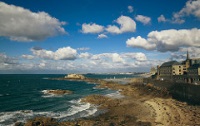
St Malo
The lively holiday resort town of St Malo has a colourful history as a fortified island citadel that was once run by corsairs who declared it a republic. Today this port on the Eng…
St Malo
The lively holiday resort town of St Malo has a colourful history as a fortified island citadel that was once run by corsairs who declared it a republic. Today this port on the English Channel swarms with tourists on holiday, its streets choked with tour buses in the summer months and its natural harbour acting as a busy ferry terminal for those crossing between Britain, France and the Channel Islands.
Because of St Malo's medieval charm, many visitors opt to spend a night or two here before their ferry crossing, and are rewarded with a pleasant sojourn behind old city walls in a quaint collection of hotels, restaurants, bars and shops. Just a hop and a skip away are some vast, clean, brown sandy beaches, ideal for family holiday fun. Visitors can troll the ramparts of St Malo's great city walls as the sun sets and it is easy to realise why this ancient city is now the most popular holiday destination in Brittany.
St Malo has many good restaurants, making it a great place to try Breton cuisine, including specialties such as Kouign Aman cake and Breton Pancakes. Seafood, specifically mussels and oysters, is another local specialty.
St Malo has a number of popular beaches. Mole is where sun-worshippers congregate, while Sillon is popular for windsurfing, and Bon Secours for sailing. There are a few historical attractions in St Malo as well, including the Ile du Grand-Bé (site of the tomb of Chateaubriand), the Historical Museum of St Malo, and St Vincent's Cathedral.
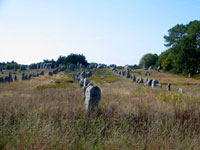
Carnac
Carnac, on the south coast of Brittany in the Bay of Biscay, is one of Brittany's most trendy holiday resorts. The family-friendly holiday resort of Carnac Plage is bright and bree…
Carnac
Carnac, on the south coast of Brittany in the Bay of Biscay, is one of Brittany's most trendy holiday resorts. The family-friendly holiday resort of Carnac Plage is bright and breezy, sporting a sand-duned peninsula, a lovely stretch of beach, plenty of entertainment, and various fun in the sun facilities. Visitors will have plenty to amuse them from watersports to more traditional tourist sightseeing.
Ironically, this popular holiday area is located alongside one of Europe's most important, ancient, and mysterious archaeological sites. Just north of the seaside town, hundreds of massive standing stones, even older than Stonehenge or the pyramids of Egypt, are aligned in rows in a field. The original purpose of these mystical monuments is unknown and visitors will no doubt come up with their own theories while wandering around the ancient site. The nearby Musée de Préhistoire complements these fascinating relics with displays of artefacts dating as far back as 450,000 BC. Such attractions ensure that Carnac has more to offer than just pretty beaches and travellers will enjoy the diversity of things to see and do in the area.
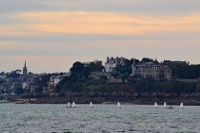
Dinard
Opposite St Malo, sitting atop a rocky headland above the Rance, Dinard was a popular holiday spot with the British in Edwardian times, valued for the bracing sea air and lovely, l…
Dinard
Opposite St Malo, sitting atop a rocky headland above the Rance, Dinard was a popular holiday spot with the British in Edwardian times, valued for the bracing sea air and lovely, long promenade. Even today, the seafront is lined with Victorian buildings, which ensure the town retains its elegant and sedate old world character.
The main Dinard beach is La Grande Plage, a strip of sand between the two peninsulas that define the edges of the old town. It is popular with families on holiday and gets crowded on hot days. Smaller and more isolated is Plage de St-Enogat, a 20-minute walk east through the village of the same name, or Plage du Prieuré, just a 10-minute walk from Dinard. There is a great difference between high and low tides, and swimming pools along the Grand Plage and the Plage du Prieuré beaches catch seawater during high tides for those who opt not to make the trek along the salt flats during low tides to bathe in the sea.
Dinard cannot boast much nightlife, despite its popularity with tourists, but there are many bars and good restaurants filling the town's streets and there is a casino for night-time entertainment.
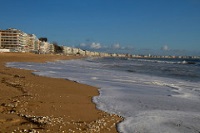
La Baule
Just west of Nantes, La Baule is Brittany's most fashionable and expensive holiday resort. Like most Breton seaside towns, it was the Victorians that first flocked here to play and…
La Baule
Just west of Nantes, La Baule is Brittany's most fashionable and expensive holiday resort. Like most Breton seaside towns, it was the Victorians that first flocked here to play and promenade in the balmy air. Today La Baule is favoured by the French rather than foreigners, a popular holiday destination for the Parisian upper-middle-class when they need to unwind.
La Baule's inviting five mile (8km) stretch of white sandy beach provides the perfect place to acquire a summer tan and show off designer beachwear while frolicking in waters warmed by the Gulf Stream. The locals boast that it is the best beach in Europe, but then many locals make that boast. It is a safe, gently sloping beach with lovely, fine sand and is good for children.
The town itself provides other holiday necessities: a casino, plenty of shops and boutiques, and some excellent bars and restaurants. There are some impressive old villas in La Baule and it is worth wandering around beyond the promenade; there are also some lovely gardens and parks open to the public. This is the place for a sophisticated, luxurious beach holiday; Brittany's version of the glamorous Cannes.
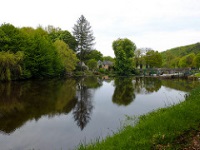
Nantes
Attractively situated on islands in the estuary of France's mighty Loire River, the city of Nantes exudes an air of importance and historical significance that makes it an interest…
Nantes
Attractively situated on islands in the estuary of France's mighty Loire River, the city of Nantes exudes an air of importance and historical significance that makes it an interesting holiday destination. Although not officially part of Brittany any longer, Nantes has always been regarded as the Breton commercial and maritime centre, once a springboard for exciting colonial expeditions, shipbuilding and trading. Today Nantes remains a wealthy industrial port, with its architectural heritage reflecting its past achievements, from the medieval remnants in the narrow streets of pedestrianised Bouffay, near the castle of the Ducs de Bretagne to the magnificent stained-glass windows of its impressive cathedral.
The city also has some good museums, including its own Musée des Beaux-Arts, which has a fine collection of sculptures and paintings from the 12th to 19th centuries, and the Musée de Jules Verne, which contains memorabilia of the famous futuristic novelist, who was born in Nantes. There is a lot to see and do in this historic, busy city and there should be something for everyone. One of the most fun attractions is Les Machines de L'ile which is a creative combination of the invented worlds of Jules Verne, the mechanical inventions of Leonardo da Vinci, and the industrial history of the city itself. It is located in the former shipyards.
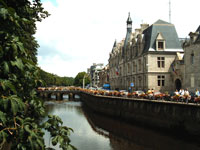
Quimper
Quimper, Brittany's oldest city, beckons those who need nothing more from a holiday than cobbled streets to wander through, a lazy river to cruise gently down and a wide selection …
Quimper
Quimper, Brittany's oldest city, beckons those who need nothing more from a holiday than cobbled streets to wander through, a lazy river to cruise gently down and a wide selection of cafés and bars to sample. The holiday town of Quimper, spread around the junction of the Steir and Odet Rivers on the western edge of Brittany, is idyllic and charming. Fortunately, Quimper was spared the bombs of World War II and has escaped too much modern development, so the medieval character remains intact with old buildings overhanging narrow lanes and footbridges.
The best way to see the city is by taking a boat trip down one of the rivers, or rambling around on foot. Visitors wanting to investigate the local crafts can tour the pottery studios that have been turning out internationally renowned Quimperware for centuries. There is also an Earthenware Museum (Musee de la Faience) to explore. Other attractions worth seeing include the Saint Corentin Cathedral, a very impressive Gothic building, and the Musee des Beaux Arts, located right next to the cathedral, which boasts some excellent paintings and sculptures and offers a good introduction to the cultural and artistic history of the region.



